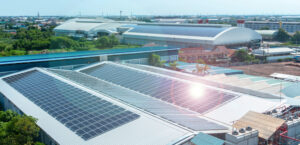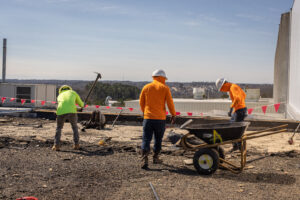As a commercial building owner or manager, you understand the importance of protecting your investment and maintaining a safe, functional environment for your tenants or employees. Your building’s roof is a critical component of that environment, and when it begins to show signs of wear or damage, you may be faced with difficult decisions.
Commercial roof restoration offers a viable alternative to costly and disruptive roof replacements, providing a cost-effective solution that breathes new life into your existing roof and helps you avoid potential disruptions to your business operations. This comprehensive guide will explore different types of commercial roofing systems, their respective restoration methods, and the benefits of commercial roof restoration.
Types of Commercial Roofing Systems and Restoration Methods
Each commercial roofing system has unique characteristics, and the restoration process for each type varies accordingly. In this section, we’ll discuss various commercial roofing systems and the specific restoration methods applied to each.
Single-Ply Membranes: TPO, PVC, and EPDM
Single-ply membrane roofs are popular in commercial buildings due to their durability, energy efficiency, and ease of installation. The restoration process for these roofing systems typically starts with a thorough cleaning to remove any debris, dirt, or contaminants that could hinder adhesion. Damaged areas are carefully repaired using compatible materials, ensuring a seamless transition between old and new sections. A liquid-applied membrane or elastomeric coating is then applied, providing a watertight seal that enhances the roof’s performance and energy efficiency.
Table 1: Comparison of Single-Ply Membrane Roofing Materials
| Material | TPO | PVC | EPDM |
|---|---|---|---|
| Durability | Moderate to High | Moderate to High | Moderate |
| UV Resistance | High | High | Moderate |
| Energy Efficiency | High | High | Moderate |
| Flexibility | High | High | High |
| Chemical Resistance | Moderate | High | Moderate |
| Cost | Moderate | Moderate to High | Low to Moderate |
Built-Up Roofs (BUR)
Built-up roofs, composed of alternating layers of bitumen and reinforcing fabrics, have been a staple in commercial roofing for decades. To restore a BUR, the roof is first inspected for any damaged areas that need to be repaired or replaced. Seams and flashing are then reinforced with a suitable fabric and adhesive. Finally, a durable, waterproof coating is applied to the entire surface to protect the roof from further damage and increase its longevity.
Metal Roofs
Commercial metal roofs, including steel, aluminum, and copper, are known for their longevity, low maintenance requirements, and aesthetic appeal. To restore a metal roof, any damaged or rusted areas are repaired or replaced, and seams and fasteners are sealed with appropriate sealants. A specialized metal roof coating is then applied, which helps prevent corrosion, improves energy efficiency, and extends the roof’s service life.
Table 2: Common Types of Metal Roofing Materials
| Material | Benefits | Drawbacks |
|---|---|---|
| Steel | Affordable, strong, resistant to corrosion | Heavier than other metals |
| Aluminum | Lightweight, corrosion-resistant, energy-efficient | Less strong than steel |
| Copper | Aesthetically appealing, long-lasting, corrosion-resistant | Expensive, softer |
Modified Bitumen Roofs
Modified bitumen roofs combine the benefits of BURs and single-ply membranes, offering flexibility and durability. The restoration process for these roofs involves repairing any damage, reinforcing seams, and applying a high-quality, weather-resistant coating to extend the roof’s lifespan and protect it from the elements.
Spray Polyurethane Foam (SPF) Roofing
SPF roofing systems consist of a spray-applied polyurethane foam that expands and solidifies, creating a seamless and highly energy-efficient layer. The restoration process for SPF roofing involves repairing damaged areas, cleaning the surface, and applying a protective coating. This coating maintains the integrity of the foam, enhances its energy efficiency, and extends its service life.
Green Roofs
Green roofs incorporate vegetation and soil layers to provide environmental benefits, such as improved stormwater management, enhanced insulation, and reduced urban heat island effects. Green roof restoration focuses on repairing any damaged areas, ensuring proper drainage, and maintaining the vegetation. This process helps to keep the roof functioning optimally and provides the environmental benefits associated with green roofs.
The Commercial Roof Restoration Process
| Step | Description |
|---|---|
| 1. Inspection and Assessment | A thorough inspection of the existing roof to identify problem areas and assess its overall condition. This inspection helps to identify any damage, potential issues, and the overall condition of the roof. Based on the findings, a customized restoration plan is developed, tailored to the specific needs of your building and roofing system. |
| 2. Cleaning and Surface Preparation | The roof surface is cleaned to remove dirt, debris, and any loose or damaged materials. This ensures proper adhesion of the coating. |
| 3. Repair and Waterproofing | Damaged areas are repaired, and seams and details are waterproofed to ensure a watertight seal. |
| 4. Base Coat Application | A base coat is applied to the entire roof surface to create a strong foundation for the top coat. |
| 5. Top Coat Application | A top coat is applied to provide a durable, weather-resistant, and reflective finish, extending the life of the roof. |
| 6. Inspection and Quality Control | A final inspection is performed to ensure the roof restoration has been done correctly and meets the required standards. |
Benefits of Commercial Roof Restoration
Commercial roof restoration offers numerous benefits, including:
- Cost-Effectiveness: Roof restoration is a more affordable option compared to a full roof replacement, as it requires less labor and materials.
- Extended Roof Lifespan: A well-executed restoration project can add up to a decade or more of life to an existing commercial roof.
- Improved Performance: The restoration process can result in a more watertight, energy-efficient, and durable roofing system.
- Reduced Energy Bills: Roof restoration systems offer solar reflectivity and emissive qualities that can improve the energy efficiency of your building, potentially reducing energy costs and extending the life of your HVAC equipment.
- Environmentally Friendly: Roof restoration extends the service life of your roof, delaying the need for a full replacement and the associated landfill waste.
Commercial Roof Restoration vs. Full Roof Replacement
| Aspect | Commercial Roof Restoration | Full Roof Replacement |
|---|---|---|
| Cost | Less expensive, typically 50-70% less than a full replacement | More expensive |
| Timeframe | Faster, less disruptive | Longer, more disruptive |
| Environmental Impact | More eco-friendly, less waste | Higher waste generation |
| Energy Efficiency | Improved due to reflective coatings, reducing energy costs | May not provide the same level of energy efficiency |
| Service Life Extension | Adds 10-20 years to existing roof lifespan | Full replacement of existing roof |
| Structural Impact | Minimal, focuses on improving the existing roof | Significant, involves removing and replacing the entire roof |
| Warranty | 10, 15, or 20 years, depending on the restoration system | Varies depending on the type of roof system and materials |
| Maintenance Requirements | Lower, restoration can reduce the need for frequent repairs | Higher, new roof may require ongoing maintenance and repairs |
Choosing the Right Contractor
When selecting a commercial roof restoration contractor, consider the following factors:
- Experience: Choose a contractor with a proven track record of successfully completing commercial roof restoration projects.
- Credentials: Ensure the contractor is licensed, insured, and holds any necessary certifications related to the roofing systems they work on.
- References: Request references from previous clients to gauge the quality of the contractor’s work and their customer service.
- Warranty: Look for a contractor who offers a comprehensive warranty on their workmanship and materials.
Commercial roof restoration is a valuable option for building owners and managers seeking to extend the life of their roofing systems, save on energy costs, and avoid the disruption of a full roof replacement. By understanding the different types of commercial roofing systems, their restoration methods, and the benefits of roof restoration, you can make an informed decision that best suits your building’s needs.
Are you ready to give your commercial roof a new lease on life? At Eskola Roofing Company, we specialize in top-quality commercial roof restoration services that save you time and money while enhancing the performance of your roofing system. Don’t wait any longer – contact us today at (800) 884-3211 or schedule a free, no-obligation inspection and consultation. Trust the experts at Eskola Roofing Company to restore your roof and protect your investment.
Once your roof is restored, it’s important to maintain it properly. Learn why you should invest in a Commercial Roof Maintenance Plan.
Additionally, find out if commercial solar roofing systems could add value to your restoration project.






